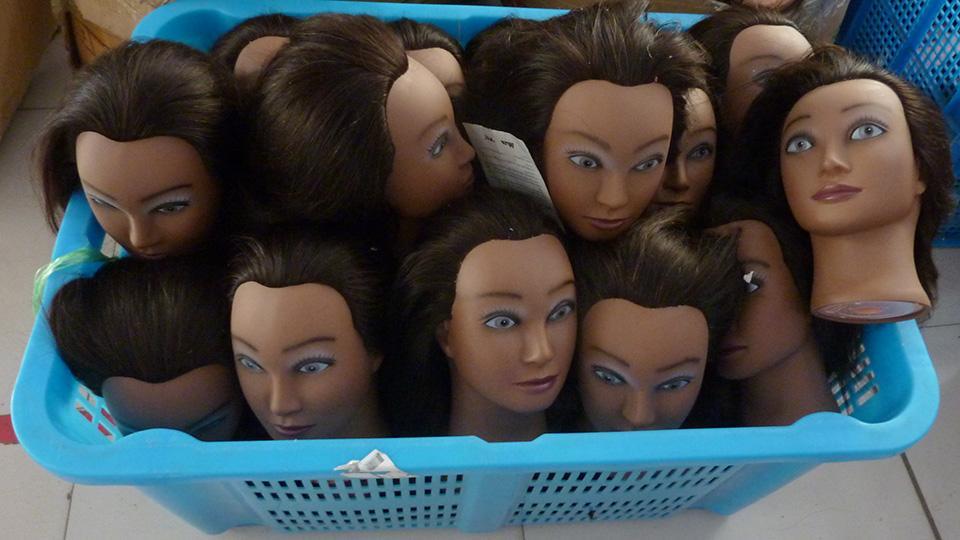New exhibition unveils more secret lives of human hair
Primary page content
Goldsmiths, University of London anthropologist Emma Tarlo is set to unveil a new exhibition exploring the curious and undiscovered world of human hair.
.jpg)
Hair weaves on the factory floor in China before export to West Africa and USA
Building on the success of her book Entanglement: Secret Lives of Human Hair, she is inviting visitors to encounter strange art works made from hair, see images of hair harvests and wig manufacture past and present, and learn about hair's recycling potential.
Hair! Human Stories runs from 7 to 26 June at The Library Space, Battersea. I spoke to Emma ahead of its opening night.
Chris Smith: How did this exhibition come about?
Emma Tarlo: When I was doing research for my book, people started giving me hair – a pigtail cut off in 1949, plaits cut off in 2012 and assorted bunches of human, goat and yak hair that had once been intended for the wig trade. At the same time I became intrigued by the range of ephemeral artefacts made using hair, from human hair rope, talismen and hair nets to eyelashes and hygrometers. I also realised it was often cheaper to buy an original historic print than to pay for its reproduction from a library archive. So slowly my own contemporary photographs of the hair trade in India, China, Myanmar, the United States and London were supplemented by historic images and hairy things.
When INFRINGE offered me the chance to curate an exhibition in the Library Space in Battersea, I was only too delighted to get a chance to share my fascination with all things hairy. This prompted me to contact artists whose hair artworks I had long admired to invite them to participate in the show. I also began collaborating with Hacketts, my local hairdresser and their clients and the end result is a conversation between art, hairdressing and anthropology.
CS: How does the exhibition shed light on the global circulation of discarded human hair?
ET: The exhibition highlights the contrast whereby hair is discarded as waste in Europe but is salvaged all over Asia and painstakingly upcycled for use in wigs and hair extensions to sell worldwide. It traces the processes by which hair is collected, sorted, crafted, re-conditioned and redistributed and gives insights into the lives of hair workers in different parts of the world. It also points to the many missed opportunities that hair offers by exploring its possibilities for recycling closer to home. Alix Bizet’s hair felts and Sanne Visser’s hair rope provide examples of how we might think about making better use of this renewable natural resource, while an eight foot long drainage mat made from human and animal fibre by the San Francisco based eco-charity, Matter of Trust, points to the potential for large scale hair recycling.
CS: What has your research told you about the cultural significance of hair?
ET: I am fascinated by the contrast between our attitudes to hair on and off the head, and the question of how it retains its connection to the person once its physical link is severed. This is something explored in the exhibition through a collaborative project with my local hair dresser, Hacketts. Clients were asked to donate some hair and comment on their feelings towards it. The exercise highlighted the fragility and ambivalence many people feel towards their hair. Displayed as a cabinet of individual hair balls with personal names, the resulting installation highlights the strangeness of disembodied hair and its tenuous lingering relationship to us.

Hairdressers' training heads in China
CS: You are hosting several events in relation to the exhibition. Can you tell us more about them?
ET: I want to encourage people to break through any inhibitions they may have about touching hair and to get involved in making things from it and reflecting about its qualities. On Saturday 9 June, we have drop in workshops for making human hair rope and felt run by designers Sanne Visser and Alix Bizet. On Thursday 14 June, we host a discussion about the art and politics of black hair with Emma Dabiri, Adom Philogene Heron and Akinola Davies Jr who directed Cynthia Harvey's film, 'This Hair of Mine'.
And on Saturday 16 June we are encouraging people to join author and illustrator Sally Kindberg in a drawing workshop and on Saturday 23 June, artist Tabitha Moses will run a hair embroidery workshop. These are all hands on activities which encourage people to engage with hair. At the same time on Thursday evenings we are running discussions. One is about the art and politics of black hair which includes a screening and discussion of Stacy Bias’s new animation, It’s Only Hair, which focuses on the experiences and coping mechanisms of young people with hair loss.
CS: What are you hoping visitors take from the exhibition as a whole?
ET: I am hoping the exhibition will encourage people to view hair in new ways. Hair is often dismissed as something superficial, related only to fashion. Yet it is fundamental to people’s sense of self, is a powerful medium for reflecting about humanity and an important material resource with recycling potential that remains largely untapped.